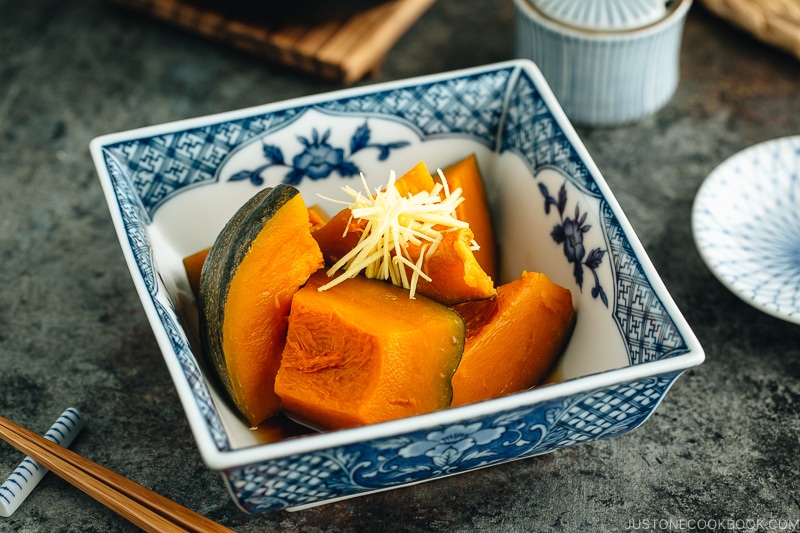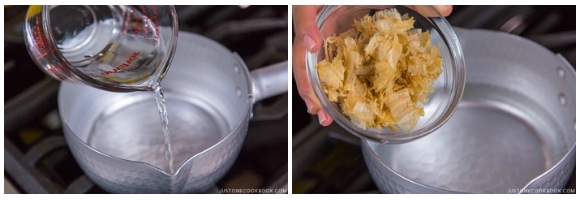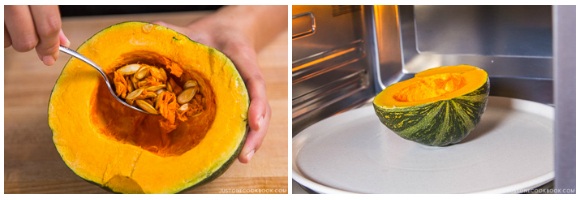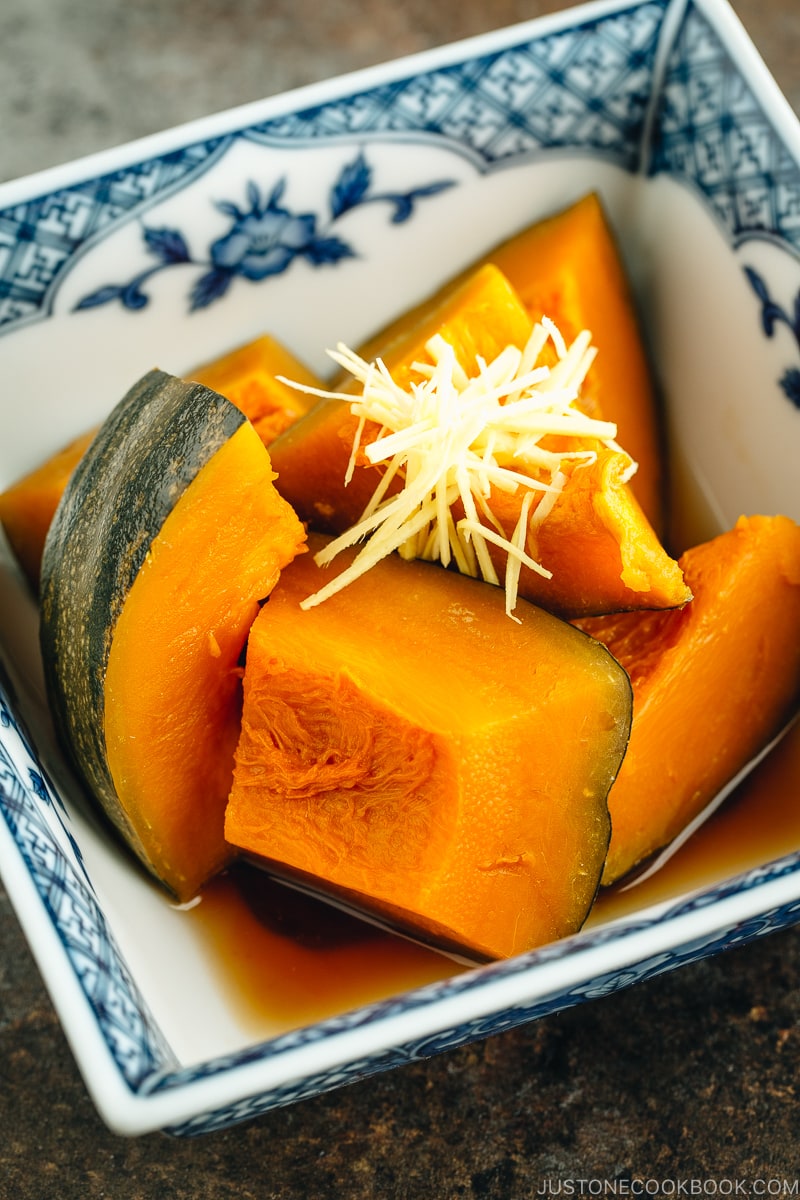Cooked in savory dashi broth seasoned with soy sauce and sake, this classic Japanese Simmered Kabocha Squash makes a satisfying and healthy side dish that is chock-full of nutrients. {vegan/vegetarian adaptable}

Japanese Simmered Kabocha Squash, or what we call Kabocha no Nimono (かぼちゃの煮物), is one of the most classic and popular simmered dishes in Japan. If you are traveling in Japan, you will see this kabocha dish everywhere. You‘ll see it in the bento box you pick up at the train station, as part of the side dishes of your teishoku (lunch meal set), or at the breakfast buffet in your ryokan (Japanese inn).
If you miss this hearty, comforting home-cooked dish, grab a kabocha squash at your local Japanese or Asian grocery store. It‘s easy to make this at home!
Table of Contents
Japanese Simmered Dish – “Nimono”
A typical Japanese home-cooked meal includes at least one simmered dish called Nimono (煮物). It can be fish or meat or different types of root vegetables all cooked and simmered in one pot. Wholesome, nutritious, and easy to prepare, these simmered dishes are considered true home cooking in a Japanese kitchen. And they make up a fundamental part of washoku (和食).
It might be surprising to you, but most of the simmered dishes are seasoned similarly – with some kind of Japanese stock, dashi (see 6 varieties here), sake, mirin, soy sauce (and sugar). What makes it different?
Based on the ingredients, we modify the ratio of the seasonings. For example, kabocha squash itself is already very sweet and flavorful, so we go easy on the sweetness (mirin or sugar) and cut down on soy sauce since we don’t want the saltiness to overpower the dish. When it comes to dashi, you can use kombu dashi, the combination of kombu and katsuo dashi, or katsuo dashi, like I used today.
3 Important Cooking Tips
1. Cut kabocha into equal size
Do not underestimate this simple tip. To make sure all the squash pieces are evenly cooked, you want to cut the kabocha squash in similar sizes. Smaller cubes will help speed up the cooking time as well.
2. Place kabocha in a single layer
Kabocha is very fragile once it’s cooked and it can break into pieces or mush easily. Therefore, you need to secure each kabocha piece, making sure they are laid in a single layer without overlapping in the pot. Then swirl the pot to mix the seasonings instead of using cooking utensils.
3. Simmer kabocha squash with just enough liquid and an otoshibuta
The amount of cooking liquid should be just enough to come to the top level of kabocha pieces in the pot. Overfilling with cooking liquid will only result in soupy kabocha, which we want to avoid.
Make sure to use an Otoshibuta (drop lid) so that the cooking liquid is forced to circulate, allowing the kabocha to cook evenly and quickly as they absorb the flavor.

Truly simple and rustic, I hope you enjoy making this Simmered Kabocha Squash recipe, especially in fall and winter. To experience more Japanese home cooking, check out other Nimono recipes on my blog and leave a comment below and let me know the kind of simmered dishes you have in mind.
Other Kabocha Squash Recipes


Japanese Simmered Kabocha
Ingredients
- 1 lb kabocha squash (½ small kabocha)
For the Dashi
- 1¾ cups water
- ½ cup katsuobushi (dried bonito flakes) (alternatively, make Kombu Dashi or Awase Dashi; make Vegan Dashi for vegan/vegetarian)
For the Seasonings
- 2 Tbsp sake
- 1 Tbsp sugar
- 2 tsp soy sauce
- ⅛ tsp Diamond Crystal kosher salt
For the Garnish (optional)
- ginger (julienned; from a 1-inch, 2.5-cm knob)
Instructions
- Before You Start…Please note that this recipe requires 30 minutes of chilling time.Gather all the ingredients.

To Make the Dashi
- In a small saucepan, boil 1¾ cups water for the dashi. Once boiling, add ½ cup katsuobushi (dried bonito flakes).

- Stir and turn off the heat. Set aside for 15 minutes to steep. Then, strain out the katsuobushi with a fine-mesh sieve. Now you have Katsuo Dashi. Set it aside. Tip: Reserve the spent katsuobushi to make furikake (rice seasonings).

To Cut the Kabocha
- Scoop out the seeds and membrane from 1 lb kabocha squash. Microwave it for 2 minutes to soften the outer skin. You can skip microwaving if you have a sharp knife and the strength to cut through the hard kabocha. Tip: See my tutorial and video on How to Cut a Kabocha Squash for more detailed instructions and techniques.

- Carefully cut the kabocha into wedges, then 2-inch (5 cm) pieces. Remember, we leave the skin on because it is edible and nutritious.

To Cook
- Place the kabocha pieces in a single layer, skin side down, in a large pot.

- Add the dashi, 2 Tbsp sake, and 1 Tbsp sugar. Swirl the pot to mix the seasonings so you don‘t break the kabocha pieces by stirring.

- Turn on the stove to medium high and bring it to a boil.

- Add 2 tsp soy sauce and ⅛ tsp Diamond Crystal kosher salt, and swirl the pot again to mix the seasonings. The cooking liquid should come three-quarters up the sides of the kabocha pieces; if it does not, you can add a little water. Bring it to a boil again.

- Once boiling, reduce the heat to medium low and maintain a simmer. Place an otoshibuta (drop lid) directly on the kabocha; learn how to make it at home or find it on Amazon and JOC Goods. Cook for 20–30 minutes, depending on the size of the pieces and skin thickness. It‘s done cooking when the orange flesh has tiny, thin cracks near the skin or a bamboo skewer pierces the flesh easily. If the liquid evaporates too fast, you can cover the pot with the pot lid (with the otoshibuta still in place).

- Remove from the heat. Cover with the pot lid and let sit until cool, about 30 minutes. This helps the kabocha absorb more flavor.
To Serve
- You can serve the simmered kabocha at room temperature or reheat before serving. To garnish with ginger (optional), cut it into thin slices and then thin julienne strips.

- Soak in cold water for 1 minute to remove some of the spiciness. Drain well. Sprinkle the ginger on top of the kabocha.

To Store
- You can keep the leftovers in an airtight container and store in the refrigerator for 2–3 days or in the freezer for a month.










Delicious! I cut my kabocha thinner and simmered it about 20 minutes. I did a whole kabocha so I wasn’t able to get it all in a single layer in the pot but it still worked out well (I think the otoshibuta helped a lot with that). A lovely balance of sweet kabocha and savory seasonings
Hello Emily! Aww. We are glad to hear you enjoyed this dish!
Thank you for trying Nami’s recipe and sharing your experience with us. 🤗
Hi. How much water should evaporate after finishing simmering? And for butternut squash, how do you suggest cutting it? I know kabocha is the standard, but I can’t find it where I live and I don’t want to miss out a great dish.
Hi, Kate! Thank you for trying Nami’s recipe.
The liquid will be roughly 1 cup when finished cooking. Kabocha will continue to absorb additional liquid as it cools. However, rather than forcing the liquid amount, we recommend checking the Kabocha’s doneness (see Nami’s tips on step 10).🙂 If you use butternut squash, cut them to the same size as in this recipe, but simmer them for little less time. Please check for doneness and modify the time as needed. We hope this helps!
I love this recipe and have made many times. What’s the best way to freeze leftovers?
Hi Krista! Thank you for trying Nami’s recipe!
You can keep the leftovers in an airtight container and store them in the freezer. Hope this works well for you!
Just made this, it tastes great but am I suppose to save the liquid with the pumpkin (and serve them with the liquid) or strain it?
Hi, Tinne! Thank you for trying Nami’s recipe.
You may serve this dish with or without the leftover sauce. It’s up to you. 🙂 We hope this helped!
How do you recommend to reheat?
Hi JC! Thank you for trying Nami’s recipe!
We recommend covering the dish and microwaving it until thoroughly warm.
Hopefully, this helps!
This was so delicious! We had tried roasting the squash before and it dried out like heck, but THIS? Amazing! So moist and delicious. When it got to the end and ran out of water the bottoms caramelized just a little 🤤! Saved! Thank you!!
Hi, Kay! We’re delighted you enjoyed Nami’s recipe!🥰
Thank you for trying her recipe and sharing your culinary adventure with us.
Lookiing forward to making this soon. I was wondering what the point of adding the ingredients separately to the pot is and then swirling, as opposed to mixing them together first and then adding to the pot. My Japanese boyfriend says “because that’s just how we do it,” but I would like to understand if there is a real reason why. Thank you so much!
Hello Julie, Thank you for trying out Nami’s recipe!
In Japanese cooking, we add ingredients in a specific order to enhance the flavor of the dish.
Firstly, sake is usually added at the beginning to help absorb the flavors of the dish. Then comes sugar, which takes longer to absorb into the dish. After that, salt is added to pull the moisture out of the ingredient and help tighten the flavor. If vinegar is required for the recipe, it is added next, followed by soy sauce and miso.
We hope this explanation helps!
Hello Nami, the recipe as written calls for arranging the squash in a single layer on the bottom of the pot. I would like to double the recipe and make a larger batch. Is it OK to add a second layer of Kabocha or do I have to make more in a separate batch? Thanks!
Hello, Maddalena. As long as Kabocha remains covered with liquid, you may apply the second layer.
Thank you for trying Nami’s recipe. We hope you loved the dish! 😊
I made this last night with a lovely little orange squash from our local organic shop here in New Zealand that was labelled “Hokkaido Pumpkin”. It is so tasty! The skin cooked perfectly tender. I enjoyed it for lunch today. Thanks for the recipe.
Hi Heather! We are so happy to hear Hokkaido Pumpink worked great for you!
Thank you for trying Nami’s recipe and sharing your experience with us.
Happy Cooking!
Hi Nami–This recipe came out great! Your site is my go-to resource for Japanese cooking–the wonderful photos, detailed information, and the clearly written recipes that always work. I’m really impressed and appreciative of the effort that you put into your site.
Hi, Catherine! Aww. Thank you so much for your kind feedback.
Nami and all of us at JOC are happy to hear that you like Nami’s recipes and everything else we have shared with you.
It meant a lot to us.
We hope you will continue to enjoy cooking with us. Happy cooking!
Have made this twice now (after finally finding an otoshibuta locally). Very easy and so flavourful.
Thank you for your recipes – I have come to appreciate kabocha and the various ways it can be prepared!
Hi Melionan, We are so happy to hear that you enjoyed Nami’s Kabocha recipes!
Thank you so much for trying her recipe and for your kind feedback.
🤗
Japanese Cooking is dignifying – Trying japanese recipes keeps me hoping.
( No ginger because now I can not find it anymore in my country – The Kabosha is a gift from another country )
Hi Feriale! Thank you so much for trying Nami’s recipe and sharing your photo of your Kabocha dish with us!
It looks delicious! Happy Cooking!
Soo good, I love kabocha and usually have it in hot pot, but this was next level savory! I also love that I can reuse the kombu from the vegetarian dashi I made. #JOCcookingchallenge
Hi huagraphie! Thank you so much for trying Nami’s recipe and sharing your cooking experience with us.
Your photo of the meal looks so delicious! Thank you for sharing your love of cooking and motivating the other readers!
Happy Cooking!
I like Japanese Simmered food but this is one of the best to make so full of flavors. Kabocha is one of my favorite vegetable after i discovered last year because of this blog. I use it for Stir-fry, soup or this delicious dish.
Hi Marco! Aww. We are so happy to hear you discovered Kabocha through our website.🥰
Thank you so much for trying Nami’s recipe and for your kind feedback. Happy Cooking!
I make this recipe all the time using any type of hearty vegetable. Daikon, onions, carrots, winter squash, you name it. I recently tried the addition of a hint of chipotle pepper and was surprised by how tasty it was. Maybe not an all-the-time thing, but can be worth trying.
Hi John! Thank you so much for trying Nami’s recipe and sharing your cooking experience with us!
Chipotle pepper sounds very interesting. 🙂
Naomi, have you tried it with other winter squashes and if so can you share the length of time simmering for those other squash varieties?
Hello, Siyucatmama. Ambercup squash, Hubbard squash, Buttercup squash, and Carnival squash all work well in this recipe and cook for a similar amount of time. However, other squash with more moisture will result in very wet dishes even if the cooking time is reduced. We hope this was helpful!